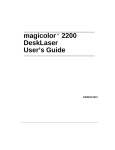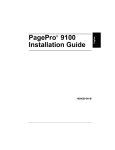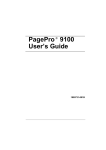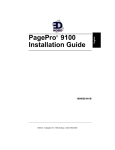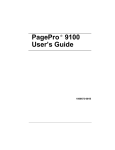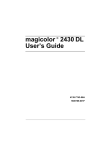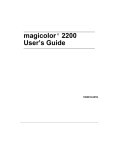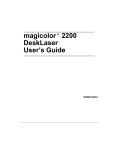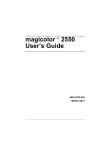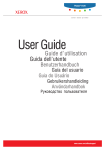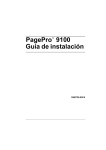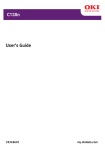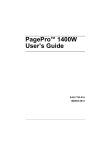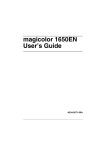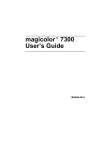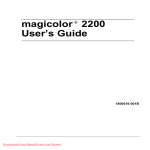Download Minolta QMS PagePro 9100 Laser Printer
Transcript
PagePro 9100 User’s Guide ® 1800672-001A Thank You Thank you for purchasing a MINOLTA-QMS printer. Trademarks The following are registered trademarks of MINOLTA-QMS, Inc.: QMS, the MINOLTAQMS logo, Crown, CrownNet, CrownView, and PagePro. Minolta is a trademark of Minolta Co., Ltd. Other product names mentioned in this guide may also be trademarks or registered trademarks of their respective owners. Proprietary Statement The digitally encoded software included with your printer is Copyrighted © 2002 by MINOLTA-QMS, Inc. All Rights Reserved. This software may not be reproduced, modified, displayed, transferred, or copied in any form or in any manner or on any media, in whole or in part, without the express written permission of MINOLTA-QMS, Inc. Copyright Notice This guide is Copyrighted © 2002 by MINOLTA-QMS, Inc., One Magnum Pass, Mobile, AL 36618. All Rights Reserved. This document may not be copied, in whole or part, nor transferred to any other media or language, without written permission of MINOLTA-QMS, Inc. Notice MINOLTA-QMS, Inc. reserves the right to make changes to this guide and to the equipment described herein without notice. Considerable effort has been made to ensure that this guide is free of inaccuracies and omissions. However, MINOLTAQMS, Inc. makes no warranty of any kind including, but not limited to, any implied warranties of merchantability and fitness for a particular purpose with regard to this guide. MINOLTA-QMS, Inc. assumes no responsibility for, or liability for, errors contained in this guide or for incidental, special, or consequential damages arising out of the furnishing of this guide, or the use of this guide in operating the equipment, or in connection with the performance of the equipment when so operated. Registering the Printer Mail—Fill out and send in the registration card enclosed in your shipment or downloaded from www.onlineregister.com/ minolta-qms/ Internet—Follow the instructions on www.onlineregister.com/ minolta-qms/ or Software Utilities CD-ROM— Follow the instructions on the CD-ROM. English Contents 1 Replacing Consumables .................................................................................. 1 Introduction 2 Consumable Life Expectancies 3 Consumables Life Expectancies Chart 5 Replacing the Toner Cartridge 6 Replacing the Exhaust Filter 12 Replacing the Pickup Roller(s) 13 Replacing the Transfer Roller 19 2 Using Media ..................................................................................................... 21 Introduction 22 Media Storage and Handling 22 Page Margins 28 Image Alignment 28 Output Tray 29 Media 30 Plain Paper 31 Envelopes 32 Label Stock 32 Postcards (Japanese size) 33 English Thick Stock 33 Transparencies 33 Loading Media 35 Using Media Other Than Plain Paper Duplexing 45 41 3 Maintaining the Printer ....................................................................................47 Introduction 48 Cleaning 49 Cleaning the Printer Exterior 49 Cleaning the Printer Interior 50 Media Tray Pickup Rollers 50 4 Troubleshooting ..............................................................................................55 Introduction 56 Printing a Status Page 57 PDF File Printing 58 Adjusting Memory Clients for PDF Printing 58 Printing Preformatted Files Using CrownView 58 Troubleshooting PDF Direct Printing from CrownView 58 Preventing Media Jams 59 Automatic Jam Recovery 60 Understanding the Media Path 60 Printer 60 Printer, Optional Tray(s), Duplexer, and 4-bin Mailbox 61 Understanding Media Jam Status Messages 62 Clearing Media Input Jams 62 Clearing Internal Jams 67 Clearing Output Jams 73 Solving Problems 74 Other Problems 78 Printing Quality 82 Status, Error, and Service Messages 85 Service Messages 92 HP-GL Error Codes and PCL Error Codes 93 PostScript Errors 94 Additional Assistance 94 5 Installing Other Accessories ..........................................................................95 Introduction 96 Antistatic Protection 98 4-bin Mailbox 98 Installing the 4-bin Mailbox 99 BuzzBox 102 Installing the BuzzBox 103 Using the BuzzBox 104 ii Contents 6 English Dual In-Line Memory Modules (DIMMs) 104 Installing Dual In-Line Memory Modules 105 Duplexer 109 Installing a Duplexer 109 Emulations, Fonts, and Other Software 111 Emulations 111 Fonts and Forms 114 Interfaces and Daughterboards 117 Interfaces 117 SCSI Interface 119 Internal IDE Hard Disk Drive 121 Optional Media Tray(s) 124 Installing an Optional Media Tray 124 Media Trays 126 Time-of-Day Clock 127 Installing a Time-of-Day Clock 127 Using the Time-of-Day Clock 129 Deinstallation and Packaging ........................................................................ 31 Introduction 132 Deinstallation 132 Packaging 135 Storing the Printer 135 Relocating Your Printer 135 Repacking the Printer 136 Remove the Cables and Media Tray(s) 137 Remove the Toner Cartridge 137 Remove the Duplexer 137 Remove the 4-bin Mailbox 137 Remove the Optional Media Trays 137 Repack the Printer 139 Checklist 139 Repacking 140 A Technical Specifications .............................................................................. 143 Requirements 144 Space Requirements 144 Location Requirements 145 Power Requirements 147 ENERGY STAR Compliance 148 Engine and Controller Specifications 149 Print Speed 149 Engine 149 Controller 150 Electrical 153 Physical 155 Contents iii English Consumable Life Expectancies 156 IPP 158 Document Option Commands 160 Header/Trailer Page Commands 160 HP-GL Emulation Commands 160 HP PCL 5e Emulation Commands 160 Lineprinter Emulation Commands 161 PostScript Emulation Command 161 CCITT Groups 3 and 4 Commands 161 Document Formatting 162 Job and Subjob Boundary Commands 162 LN03 Plus Commands (Optional Emulation Required) 162 CALS Commands (Optional Emulation Required) 163 TIFF Commands (Optional Emulation Required) 163 Menus 164 Configuration Chart Conventions 164 Security Menu 164 Operator Control Menu 165 Administration Menu 166 Administration/Communications/Optional NIC/CrownNet Menu Warranty Considerations 172 Manufacturer’s Declarations of Conformity 174 167 Index......................................................................................................................177 iv Contents Replacing Consumables 1 Introduction 2 Item Page “What is a consumable?” page 3 “What is a face?” page 3 “What is the life expectancy of consumables?” page 4 “How do I order consumables?” page 5 “Where can I get more information?” page 5 “What is the toner cartridge life expectancy?” page 6 “How should I handle a toner cartridge?” page 7 “How do I replace and recycle the toner cartridge?” page 8 “How do I replace the exhaust filter?” page 12 “How do I replace pickup rollers?” page 13 “How do I replace the transfer roller?” page 19 Introduction Consumable Life Expectancies What is a consumable? A consumable is an item that needs to be replaced at regular intervals. For the PagePro 9100, consumables include: Service replaceable „ Fuser User replaceable „ Toner cartridge and exhaust filter „ Pickup rollers „ Transfer roller Although the printer was designed for printing on a wide range of media types, it is not intended to print exclusively on a single media type except plain paper. Continuous printing on media other than plain paper (such as envelopes, labels, thick stock, or transparencies) may adversely affect print quality or reduce engine life. What is a face? A face is a single pass of media past the toner cartridge. A two-sided (duplex) page (also called a sheet) consists of two passes of the toner cartridge. 5" The number of sheets printed statistics shown on the startup page may differ from the sheets printed and faces printed statistics in CrownView (a printer-based application for accessing printer configurations, status, and consumables usage information) and on the consumables statistics page (Operator Control/Consumables/Print Statistics). The numbers on the startup page refer to number of sheets/faces printed during the lifetime of the printer. The numbers in CrownView and on the consumables statistics page refer to the number of sheets/ faces printed to date during the current consumables tracking period (Administration/Consumables/Start Period menu). For further information about CrownView, refer to the CrownBooks in PDF on the Software Utilities CD-ROM. Consumable Life Expectancies 3 What is the life expectancy of consumables? Attention Consumable life is expressed in simplex letter/A4 pages @ normal 5% coverage in continuous printing. A duplex page is equivalent to two simplex pages. The stated life expectancy of each consumable is in page coverage (usually 5% coverage of letter/A4-size media), and continuous printing —for example, an average four-page run length (optimal consumable life), or intermittent printing—for example, one-page jobs. The actual life expectancy will vary based on printing under specific operating conditions and other printing variables, such as ambient temperature, humidity, media type, page size, and content of material printed—for example, text or graphics. Attention Failure to follow instructions as outlined in this manual could void your warranty. Use of consumables not manufactured by MINOLTA-QMS or use of non-supported print media may cause damage to your printer and void your warranty. If MINOLTA-QMS printer failure or damage is found to be directly attributable to the use of non-MINOLTA-QMS consumables, MINOLTA-QMS will not repair the printer free of charge. In this case, standard time and material charges will be applied to service your printer for that particular failure or damage. 4 Consumable Life Expectancies Consumables Life Expectancies Chart Item Fuser Average Life Expectancy (in Simplex Pages) 300,000 intermittent printing (for example, one-page jobs) Comment The fuser must be replaced by a MINOLTA-QMSauthorized service provider. Refer to the Service & 500,000 continuous printing Support Guide or www.minolta-qms.com for (average four-page jobs) further information. Toner Cartridge Starter Cartridge = 6,000 Replace the toner cartridge and Exhaust Replacement Cartridge = and the exhaust filter (if you Filter 15,000 continuous printing don’t have a duplexer or 12,000 intermittent installed) at the same time. printing See “How do I replace and recycle the toner car(TONER EMPTY displays in tridge?” on page 8. the message window.) Media Pickup Approximately 150,000 See “How do I replace the Rollers pickup rollers?” on page 13. Transfer Roller Approximately 150,000 See “How do I replace the transfer roller?” on page 19. How do I order consumables? Choosing the right consumables for your printer not only increases its reliability and performance, but also minimizes the risk of damage. For example, only MINOLTA-QMS toner cartridges are designed to meet the exact specifications of your MINOLTA-QMS printer, giving maximum performance, efficiency, and long life. Toner cartridges and other consumables for your printer are available from your local vendor or Q-SHOP (www.q-shop.com). Where can I get more information? To access consumables usage information, use the Operator Control/ Consumables/Print Statistics menu on the control panel, or use the CrownView printer web page. For further information about the consumables statistics page and replacement menus, refer to the CrownBooks in PDF on the Software Utilities CD-ROM. For information about ordering consumables, refer to www.minolta-qms.com or www.q-shop.com. If you need more assistance, more information can be found on the AnswerBase at www.minolta-qms.com (click on On-Line Help & Drivers). Consumable Life Expectancies 5 Replacing the Toner Cartridge Characters and images are created in your laser printer through a process that applies toner to the photosensitive OPC (Organic Photo Conductor) inside your toner cartridge. Your printer uses one toner cartridge. Handle the toner cartridge carefully to avoid spilling toner inside the printer or on yourself. When the toner cartridge is worn out, the message TONER EMPTY appears. The printer will not print until the toner cartridge is replaced. After the toner cartridge is replaced, the printer automatically resets the consumables count. Attention The OPC inside the toner cartridge is extremely sensitive to bright light, direct sunlight, and touch. Always leave the toner cartridge in its protective package until you’re ready to install it. Any exposure to light should be avoided and limited to less than two minutes, or permanent damage could result. If you suspect the OPC is damaged due to exposure to light, put the toner cartridge in a dark place to recover. Recovery may take up to two hours. Recovery time is dependent on the amount of exposure sustained, and recovery is not guaranteed. What is the toner cartridge life expectancy? Toner cartridge life is directly related to the number of rotations of the OPC. Longest unit life is achieved with continuous printing which requires a cleaning rotation after every fourth page of an average size job. Intermittent printing with small job sizes requires a cleaning rotation after each one-page simplex job, and therefore impacts OPC life. 6 Replacing the Toner Cartridge A toner cartridge contains enough toner to print letter/A4-size pages at the percent coverage stated (other factors will also affect toner life): Coverage Starter Cartridge Replacement Cartridge (Continuous Printing) Replacement Cartridge (Intermittent Printing) 5% 6,000 15,000 12,000 10% 3,000 7,500 6,000 15% 2,000 5,000 4,000 20% 1,500 3,750 3,000 When a toner cartridge runs low, TONER LOW displays in the message window and ther is approximately 5% toner remaining. Printing continues even though the warning appears. However, the image gradually fades, so replace the toner cartridge as soon as possible. Approximately 750 pages after the printer displays TONER LOW in the message window, the printer displays TONER EMPTY, and the printer stops. How should I handle the toner cartridge? Keep the toner cartridge „ Away from open flames. „ In its packaging until you’re ready to install it. „ In a cool, dry location away from sunlight (due to heat). The maximum storage temperature is 95 ° F (35 ° C) and the maximum storage humidity is 80% without condensation. If the toner cartridge is moved from a cold place to a warm, humid place, condensation may occur, degrading print quality. Allow the toner to adapt to the environment for about one hour before use. „ Level during storage. Do not store cartridges on their ends or turn them upside down; the toner inside the cartridges may become caked or unequally distributed. „ Away from salty air and corrosive gases such as aerosols. Replacing the Toner Cartridge 7 How do I replace and recycle the toner cartridge? Base Printer 1 Open the top cover c, d. 2 1 Attention Never touch the copper or brass electrodes c or electrical parts that are located inside the top cover and underneath the toner cartridge, as a printer malfunction can result. c 1 2 d e 3 Be careful not to touch d# around the image transfer roller (touching certain parts in this area may result in reduced print quality) or e around the fusing unit (since the inside reaches temperatures of about 392 °F (200 °C), touching any part in this area may result in burns). 8 Replacing the Toner Cartridge 2 Recycle the used toner cartridge. a Seal the empty MINOLTA-QMS toner cartridge in its original box. b Affix the prepaid UPS label on the top of the box and return it via UPS. If you did not receive a label with your cartridge or have misplaced the label, send an email to [email protected] for a replacement label. 3 4 Remove the new toner cartridge from its box. 5" We strongly suggest that you save the packaging materials in case you ever need to replace the toner cartridge, or move or ship the printer. Peel off the packing tape. Attention Do not open the protective coverc c of the OPC (the green area) d or hold the toner cartridge by the protective cover. The OPC is extremely sensitive to hand oils and scratches, both of which reduce print quality. This type of damage is not covered by your warranty. Replacing the Toner Cartridge 1 c 2 d 9 5 Slowly shake the toner cartridge, tilting it to the left and right 7 or 8 times to distribute the toner. The toner is nontoxic. If you get toner on your hands, wash them in cool water and mild neutral detergent. If you get toner on your clothes, lightly dust them off as much as possible. If some toner remains on your clothes, use cool, not hot water, to rinse the toner off, provided your clothing is washable. WARNING! If you get toner in your eyes, wash it out immediately with cool water and consult a doctor. Material Safety Data Sheets (MSDS) can be found at www.minolta-qms.com (click on Online Help & Drivers). Sollte Toner in Ihre Augen gelangen, die Augen unbedingt sofort mit kaltem Wasser ausspülen und einen Arzt aufsuchen. MSDS (Material Safety Data Sheets; Datenblätter zur Materialsicherheit) finden Sie im Internet unter www.minolta-qms.com (klicken Sie auf “Online Help & Drivers”). 6 7 Align the tabs on the toner cartridge (one on each side) with the notches in the printer, and then insert the cartridge as far as possible into its compartment. Close the top cover. Attention Do not transport the printer with the toner cartridge installed. If toner spills within the printer, decreased print quality may result, or the printer may be damaged. 10 Replacing the Toner Cartridge Printer with 4-bin Mailbox Attached 1 2 Slide the 4-bin mailbox to the back of the printer. Open the top cover. 2 1 3 4 Lower the stopper to support the top cover. Replace the toner. Refer to “How do I replace and recycle the toner cartridge?” on page 8. 5 6 7 Return the stopper to its original position c. Close the top cover d. 1 2 After closing the top cover, slide the 4-bin mailbox forward to its original position. Replacing the Toner Cartridge 11 Replacing the Exhaust Filter If you haven’t installed the optional duplexer, the exhaust filter on the back of the printer is replaced when you replace a toner cartridge. How do I replace the exhaust filter? 1 Remove the used exhaust filter. 5" Dispose of it according to your local regulations. Attention If you will be installing the optional duplexer, it contains a built-in exhaust filter that does not need replacement. 2 12 Remove the new filter from its box and insert it into place. Replacing the Exhaust Filter Replacing the Pickup Roller(s) The pickup rollers feed media from the media trays into the printer. When the pickup rollers deteriorate, media may not feed correctly, resulting in media jams. Replace the pickup roller in each 500-sheet media tray and in the multipurpose tray each time you replace the fuser, and more frequently if the media is not being picked properly. Five pickup rollers are included in the kit—one for the standard media tray, three for the optional tray(s), and one for the multipurpose tray. If you do not have optional media tray(s), the three extra rollers do not need to be installed. How do I replace the pickup rollers? Media Tray Pickup Rollers 1 Pull the media tray out of the printer until it stops. The illustration shows the standard upper media tray. Follow the same instructions for the optional media tray(s). 2 Remove the media tray. 2 1 Replacing the Pickup Roller(s) 13 3 Remove the old pickup roller. a b c d Unclip the clip c. Gently raise the bar d, and slide it to the left. Remove the second clip e, and remove the used pickup roller f. Dispose of the old pickup roller. 5" Dispose of it according to local regulations. 4 3 1 2 5 6 Remove the new pickup roller from its packaging. Install the new media pickup roller. a b c d 5 6 14 Slide it on c.# Replace the clip d. 1 2 Reposition the bar e to the right. Replace its clip f. 4 3 Reinsert the media tray into the printer. If you have optional media tray(s) installed, repeat steps 2–6 for each one. Replacing the Pickup Roller(s) Multipurpose Tray Pickup Roller 1 Turn off the printer. 2 Open the top cover. Attention Never touch the copper or brass electrodes c or electrical parts that are located inside the top cover and underneath the toner cartridge, as a printer malfunction can result. 1 2 3 e Be careful not to touch d# around the image transfer roller (touching certain parts in this area may result in reduced print quality) or e around the fusing unit (since the inside reaches temperatures of about 392 °F (200 °C), touching any part in this area may result in burns). Replacing the Pickup Roller(s) 15 3 4 5 Remove the toner cartridge and store it in a light-free protective bag. Open the media feed roller cover. Unscrew the screw in the center of the multipurpose tray pickup roller and dispose of the pickup roller. 5" 16 Dispose of it according to your local regulations. Replacing the Pickup Roller(s) 6 Remove the new pickup roller from its packaging. Attention Do not touch the two black parts of the roller. CR_M12K.EPS 7 Align the peg on the bottom of the pickup roller in its hole, and replace the pickup roller. 8 Tighten the screw. 9 Close the media feed roller cover. Replacing the Pickup Roller(s) Peg hole 17 10 18 Align the tabs on the toner cartridge (one on each side) with the notches in the printer, and then insert the cartridge as far as possible into its compartment. 11 Close the top cover. 12 Turn on the printer. Replacing the Pickup Roller(s) Replacing the Transfer Roller The transfer roller interfaces with the roller in the toner cartridge. How do I replace the transfer roller? 1 2 Turn off the printer. Slide the top cover release lever to the right c, and open the top cover d. 2 1 3 4 Remove the toner cartridge and store it in a light-free protective bag. Place your fingers underneath the green tabs and rotate the roller upward away from you c. 1 c 1 c The metal surface will move upward. 5 Remove the used transfer roller d. 5" Dispose of it according to your local regulations. Replacing the Transfer Roller 2 d 19 6 Remove the new transfer roller from its packaging. Attention Do not touch the transfer roller’s black surface. 7 8 9 10 11 20 .Lower the new transfer roller straight in c, making sure the shaft is well seated. Rotate the green tabs downward d so that the metal surface faces you. 2 d 1 c 2 d Align the tabs on the toner cartridge (one on each side) with the notches in the printer, and then insert the cartridge as far as possible into its compartment. Close the top cover. Turn on the printer. Replacing the Transfer Roller Using Media 2 Introduction This chapter provides information on handling, selecting, and storing media. Getting Started “How do I take care of media?” page 22 “What should I watch out for when handling media?” page 25 “What type and amount of media can I load?” page 26 “What sizes of media can I use?” page 27 “What is the imageable (printable) area” page 27 “What Is the guaranteed imageable (printable) area?” page 27 Job Modes and Media Types “Why have two different job modes?” page 30 “How do I select the job mode?” page 31 “What type and amount of media can I load?” page 26 “How do I select the media type?” page 31 Other Information “How do I refill media tray?” page 35 “How do I manually duplex?” page 45 “How do I autoduplex?” page 45 “Where can I order MINOLTA-QMS-approved media or get more information?” page 46 Attention Using unsupported media such as inkjet paper or coated color transparencies will result in damaging the printer and in voiding your warranty. Media Storage and Handling How do I take care of media? Keep media on a flat, level surface in its original wrapper until it is time to load it. If media has been removed from its wrapper, place it in its original packaging and store in a cool, dark place. 22 Introduction When storing media, avoid „ Moisture, excess humidity Keep media between 30% to 65% relative humidity. Toner does not adhere well to moist or wet paper On the other hand, media that has been stored for a long time without staying in its packaging may dry up too much and also cause jamming. „ Direct sunlight „ Excess heat (up to 86° F/30° C) „ Dust „ Leaning against other objects or placed in an upright position Before purchasing a large quantity or special media, do a trial printing with the same media and check print quality. What should I watch out for when handling media? Attention Do not use the media types listed below. These could cause poor print quality, media jams, or damage to the printer. Do not use media that is „ Coated with a processed surface (such as carbon paper, digitally glosscoated media, colored paper that has been treated) „ Carbon backed „ Iron-on transfer media (heat-sensitive paper, heat-pressure paper, heat-press transfer paper) „ Cold water transfer paper „ Pressure sensitive „ Special media designed specifically for inkjet printers (superfine paper, glossy paper, glossy film, postcards, etc.) „ Media that has already been printed on – – – – An inkjet printer A monochrome or color laser printer or copier A heat-transfer printer Another printer or fax machine „ Wet (or damp) „ Layered „ Adhesive Media Storage and Handling 23 „ Folded, creased, curled, embossed, warped, or wrinkled „ Perforated, three-hole punched, or torn „ Too slick, too coarse, too textured „ Different in texture (roughness) on the front and back „ Too thin or too thick „ Stuck together with static electricity „ Composed of foil or gilt; too luminous „ Heat sensitive or cannot withstand the fusing temperature (392° F/200° C) „ Irregularly shaped (not rectangular or not cut at right angles) „ Attached with glue, tape, paper clips, staples, ribbons, hooks, or buttons „ Acidic „ Any other media that is not approved Use media that is „ Suitable for plain-paper laser printers, such as standard or recycled office paper What should I watch out for when loading envelopes? Do not use envelopes that have „ Sticky flaps „ Tape seals, metal clasps, paper clips, fasteners, or peel-off strips for sealing „ Transparent windows „ Too rough of a surface „ Material that will melt, vaporize, offset discolor, or emit dangerous fumes „ Been presealed Use envelopes that are „ Common office envelopes with diagonal joints, sharp folds and edges, and ordinary gummed flaps „ Approved for laser printing „ Dry „ Printed on the front address side only What should I watch out for when loading labels? Do not use label sheets that „ Have labels that easily peel off 24 Media Storage and Handling „ Have the backing sheets that have peeled away or have exposed adhesive Labels may stick to the fuser, causing them to peel off and media jams to occur. „ Are precut Do not use Shiny backed paper OK to use Paper cut into labels Full page labels (uncut) Use label sheets that are „ Recommended for laser printers What should I watch out for when loading postcards? Do not use postcards that are „ Coated „ Warped „ Designed for injet printers „ Multicolored „ Preprinted or multicolored (may result in printer jamming) Use postcards that are „ Japanese Post Office standard postcards (3.9 x 5.8:” [100 x 148 mm]) recommended for laser printers What should I watch out for when loading transparencies? Attention Use only the MINOLTA-QMS-approved transparencies. Check www.minolta-qms.com for current approved media. To order approved media, go to www.q-shop.com. Do not use transparencies that „ Are coated, such as transparencies designed for color printers or copiers „ Have static electricity that will cause them to stick together Media Storage and Handling 25 Use transparencies that are „ Monochrome, uncoated transparencies (also known as OHP film) What type and amount of media can I load? Paper Source Paper Type Plain Sheets Allowed Recycled Sheets Allowed Special Media Sheets Allowed Notes 500-sheet Upper Media Tray* 200-sheet Multipurpose (MPT) Tray Optional Media Trays* (Optional1, Optional2, Optional3) 500 Paper weighing 500 200 16–24 lbs (60– 90 g/m2) ** Paper weighing 550**** 250*** 550*** 16–24 lbs (60– 90 g/m2)** Transparencies Not 20**** Not supported supported Labels Envelopes Thick Stock*** 24–90 lbs (91–163 g/m2) Postcards Sheets * You may rename these trays for your convenience. See the CrownBooks (in PDF on the Software Utilities CD-ROM) for more information. ** Duplexing is supported only up to 28 lb (105 g/m²) bond. *** Maximum weight 64 g/m2. **** Maximum weight 163 g/m2. Load the media face-up with its top toward the back of the printer. Often, an arrow on the media package label indicates the printing-side of the media. If you can’t remember which side of the media to print on, remove the media from the tray, rotate the stack 180°, turn the stack over, and then place it back in the tray. Attention Do not allow media to go above the fill limit mark inside the tray or the media may not be fed correctly. 26 Media Storage and Handling What sizes of media can I use? Media Media Size Inches Millimeters Feed Input Output Direc- Source Source tion Autoduplex 8 Kai 10.2x14.6 260.0x370.0 SEF M Top No 16 Kai 7.3x10.2 185.0x260.0 LEF M Top No 32 Kai 5.1x7.3 130.0x185.0 LEF M Top No A3 11.7x16.5 297.0x420.0 SEF UO/M Top/Mbox Yes A4 Plain Paper 8.2x11.7 210.0x297.0 LEF UO/M Top/Mbox Yes A4 Transparency 8.2x11.7 210.0x297.0 SEF M Top No A5 5.9x8.3 148.0x210.0 LEF M Top Yes B4 10.1x14.3 257.0x364.0 SEF UO/M Top/Mbox Yes B5 (ISO) 6.6x9.8 176.0x250.0 LEF M Top Yes B5 (JIS) 7.2x10.1 182.0x257.0 LEF UO/M Top/Mbox Yes C5 6.4x9.0 162.0x229.0 SEF M Top No C6 4.5x6.4 114.0x162.0 SEF M Top No Commercial #10 4.1x6.4 Envelope 105.0x241.3 SEF M Top No International DL Envelope 4.3x8.7 110.0x220.0 SEF M Top No Executive 7.3x10.5 184.0x267.0 LEF M Top/Mbox Yes Folio 8.5x13.0 216.0x330.0 SEF M Top/Mbox Yes Japanese Postcard 3.9x5.8 100.0x148.0 SEF M Top No Label (Letter or A4) 8.5x11.0 8.2x11.7 215.9x279.4 SEF 210.0x297.0 M Top No Ledger 11.0x17.0 279.4x432.0 SEF UO/M Top/Mbox Yes Legal 8.5x14.0 215.9x355.6 SEF UO/M Top/Mbox Yes Letter 8.5x11.0 215.9x279.4 LEF UO/M Top/Mbox Yes Letter Transparency 8.5x11.0 215.9x279.4 SEF M Top No Monarch 3.9x7.5 98.0 x 191.0 SEF M Top No Statement 5.5x8.5 140.0x216.0 LEF M Top Yes Notes: LEF = Long-edge feed; SEF = Short-edge feed; UO = Upper or optional media tray(s); M = Multipurpose tray; Mbox = 4-bin Mailbox Thick stock (91–163 g/m2) cannot be autoduplexed or output to the 4-bin mailbox. What Is the guaranteed imageable (printable) area? Each media size has a specific imageable area, the maximum area on which the printer can print clearly and without distortion. Media Storage and Handling 27 This area is subject to both hardware limits (the physical media size and the margins required by the printer) and software constraints (the amount of memory available for the full-page frame buffer). The guaranteed imageable (printable) area for all media sizes is the page size minus 0.157" (4 mm) from all edges of the media. 0.157" (4 mm) Edge-to-edge printing is available through the printer’s control panel (Administration/Engine/ Edge-to-Edge menu). Edge-to-edge printing outside the 0.157" (4 mm) margin is nonguaranteed. The nonguaranteed area is the area on which you can print, but image quality in these areas might be compromised. Edge-to-edge printing is selectable within the driver through custom page sizes only. Envelopes have a nonguaranteed flap area that varies with envelope type. 5" Envelope print orientation is determined by your application. Nonimageable area 0.157" (4 mm) Nonguaranteed area Guaranteed area* Page Margins Margins are set through your application. Some applications allow you to set custom page sizes and margins while others have only standard page sizes and margins from which to choose. If you choose a standard format, you may lose part of your image (due to imageable area constraints). If you can custom-size your page in your application, use those sizes given for the imageable area for optimum results. Image Alignment If for any reason, you need to change the image alignment, you can do so in several different ways: 28 Media Storage and Handling „ Adjust the margins or page size through your application (recommended method). „ Use the printer’s control panel (Administration/Engine/Image Alignment or the Administration/Engine/Edge-to-Edge menu). „ Use the PostScript translate and scale operators to reduce image size and change its placement on the page (requires PostScript programming knowledge). Output Tray The single face-down output tray has a capacity of 500 sheets of 20 lb (75 g/m2) bond paper. If the media stacks too high, your printer may experience media jams, excessive media curl, or static buildup. Remove transparency media as soon as it’s printed. Media Storage and Handling 29 Media Attention Use only the MINOLTA-QMS-approved media. Check www.minolta-qms.com for current approved media. To order approved transparency media, go to www.q-shop.com. „ Try printing your data on a plain sheet of paper first to check placement. „ Media is fed either on the short or long edge, depending on the size of the media. See “What sizes of media can I use?” on page 27. „ Test any stock (and the number of sheets of thick stock a media tray can hold) thicker than 24 lb bond (90 g/m²) to ensure that its performance is acceptable. „ Select Network Mode or Single User Mode (job modes) to specify how media type requests are handled. „ Select the media type. Why have two different job modes? Network mode is designed for printing on the network, so that print jobs are not held up by requested media changes. If the requested media type from the driver matches the media type set for the inputbin, the job will print on the requested media type. If the printer does not sense a requested media type (such as transparency) in the inputbin selected in the driver, it will continue and print the job on plain paper. Single user mode is designed to allow a printer to stop and request a specific media type (such as transparency or thick stock) when requested by the driver, regardless of the current media type in the inputbin. This allows more flexibility in the individual print job, but it can bottleneck the printing process if the printer is waiting for a media change and you do not physically go to the printer and make the change. Since MINOLTA-QMS printers use a First-In First-Out order in job processing, all print jobs will be paused, waiting for the media change. Which job mode is best? The specific mode that is best depends upon your particular network environment. If getting your jobs printed in a timely manner is most important, use network mode. If getting your jobs printed on the requested media is most important, use single user mode. 30 Media How do I select the job mode? In network mode, you must select a specific media type from the printer driver and Network Mode from the printer’s control panel (Operator Control/Media Mode/Network Mode). In single user mode, you only have to specify the type of media that you are printing on in the driver. How do I select the media type? For example, in the printer driver (Paper tab, Media Type option), select Plain Paper. Plain Paper Media Type Plain paper Input Tray Upper (standard) Multipurpose Optional media tray(s) Capacity Upper: 500 sheets* of 20 lb bond (75 g/m²) paper; capacity for other weights varies accordingly. Multipurpose: 200 sheets of 20 lb bond (75 g/m²) paper; capacity for other weights varies accordingly. Optional (each tray): 500 sheets (x3)* of 20 lb bond (75 g/m²) paper; capacity for other weights varies accordingly. Orientation Face up Weight 16–24 lb bond (60–90 g/m²) Duplexing Supported up to 24 lb bond (90 g/m²). Warning Using unsupported media, such as inkjet paper, will result in damaging the printer and in voiding your warranty. Notes *For A5-size media, load up to 350 sheets only. Media 31 Envelopes Media Type Envelope Input Tray Multipurpose tray only Capacity Up to 100, depending on the thickness of the envelopes Orientation Face up Weight Not applicable; use only approved media. Duplexing Not supported Label Stock Media Type Label stock, only in letter- or A4-size sheets. Input Tray Multipurpose tray only Capacity Up to 50 sheets, depending on the thickness of the labels Orientation Face up Weight Not applicable; use only approved media. Duplexing Not supported Notes „ A label consists of a face sheet (the printing surface), adhesive, and a carrier sheet — The face sheet must follow the plain paper specification. — The face sheet surface must cover the entire carrier sheet, and no adhesive should come through on the surface. „ You can print continuously with label paper. However, this could affect the media feed, depending on the media quality and printing environment. If problems occur, stop the continuous print and print one sheet at a time. „ Format label data within your application. Try printing your data on a plain sheet of paper first to check placement. „ Check your application documentation for other information on printing labels. 32 Media Postcards (Japanese size) Media Type Postcard Input Tray Multipurpose tray only Capacity Up to 100 sheets, depending on the thickness of the postcards Orientation Face up Weight Not applicable; use only approved media. Duplexing Not supported Notes „ If the postcard is warped, press on the warped area before putting it in the multipurpose tray. Thick Stock Media Type Thick Input Tray Multipurpose tray only Capacity Up to 50 sheets, depending on the thickness of the media Orientation Face up Weight 24 lbs (90 g/m²) to 90 lbs (163 g/m²) Duplexing Not supported. Notes „ Test all thick stock to ensure acceptable performance and to ensure that the image does not shift. „ Do not mix thick stock with any other media in the media trays, as this will cause printer jamming. Transparencies Media Type Transparency Input Tray All input sources Capacity Up to 100 sheets, depending on the thickness of the transparencies Orientation Face up Media Size Only letter and A4 sized transparencies are supported. Weight Not applicable; transparencies are measured by thickness. Duplexing Not supported Media 33 Notes „ Use monochrome, uncoated transparencies (also known as OHP film) „ Remove transparency media as soon as possible from the output tray to avoid static buildup. „ If you touch the face of transparencies with your bare hands, print quality may be affected. Do not handle transparency media too much. „ Do not fan large quantities of transparency media before loading it. „ You can print continuously with transparencies. However, this could affect the media feed, depending on the media quality, static buildup, and printing environment. For the multipurpose tray, if you have problems loading a large number of transparencies at a time, try loading only 1–10 sheets. 34 Media Loading Media For information about approved media, refer to “Media” on page 30. Check www.minolta-qms.com for current approved media. To order approved media, go to www.q-shop.com. How do I prepare the media? 5" 1 2 Don’t unwrap paper above the printer, as this might cause paper particles to fall into the printer. Take off the top and bottom sheets of a ream of paper. Fan a stack of approximately 500 sheets of paper to prevent static buildup. Don’t fan large quantities of transparency media. A fill limit mark is provided on the inside right side of the tray. The upper and optional media tray(s) hold approximately 500 sheets of 20 lb bond (75 g/m²) paper. How do I refill a media tray? 1 Pull out the media tray until it stops. 5" The illustration only shows the upper media tray. The following instructions are also valid for the optional media trays. Loading Media 35 2 While pressing in the release buttons (one on each side) c, remove the tray d. 2 1 3 4 Remove the media tray cover. Lift up the gray lever on the right end of the paper retainer c, and then slide the paper retainer to the right d. 2 1 5 Lift up on the left end of the paper retainer c to remove it d. 1 2 36 Loading Media 6 Insert the right end of the paper retainer c into the slot for the size of paper to be loaded d. 2 The paper size is detected depending on the position of the paper retainer. Correctly position the paper retainer according to the size of paper to be loaded. 7 1 Slide the paper retainer to the left c, and then press down on the gray lever d to secure the paper retainer. Attention Make sure the paper retainer is seated properly. 8 Align the four edges of the paper, and then load the paper printing side up. „ A4, B5, Letter, and smaller paper short-edge feed (SEF). „ A3, B4, Ledger, and larger paper long-edge feed (LEF). A4, B5, Letter, and Smaller A3, B4, Ledger, and Larger A maximum of 500 sheets (20 lb bond [75 g/m2] plain paper) can be loaded. If media is loaded past the triangular mark, it may not be fed correctly. Loading Media 37 9 Press in the button on the paper guide c, and then slide the guide against the edge of the paper d. Attention The media should fit easily between the guides. Improperly adjusted guides may cause poor print quality, media jams, or printer damage. 10 11 38 2 1 Install the media tray cover. Install the media tray, inserting it as far as possible into the printer. Loading Media 12 13 When printing on media B4 or larger, fold open the output tray extension. Affix the media size labels (supplied with the printer) to the media tray(s) in order to indicate the size of the loaded paper. How do I refill a multipurpose media tray? For information about approved media, refer to page 26. The multipurpose tray is used for all media types, especially envelopes, labels, Japanese-sized postcards, and thick stock. 1 Open the multipurpose tray. Loading Media 39 2 While pressing in the button c on the media guide at the right, slide the media guide d to adjust it to the approriate size. 2 1 3 Fan a stack of media. A fill limit mark is provided on the inside of the tray. A maximum of 200 sheets (75 g/m2 plain paper) can be loaded. If media is loaded past the triangular mark, it may not be fed correctly. 4 Align the four edges of the media, and then lightly slide the media as much as possible into the feed slot (printing-side up). Often, an arrow on the package label indicates the printing-side of the media. Attention Make sure the media fits easily between the guides. Improperly adjusted guides may cause poor print quality, media jams, or printer damage. 40 Loading Media Using Media Other Than Plain Paper Attention For information about media recommended for your printer, go to www.minolta-qms.com/support, then click on the Answer Base. Attention Although your printer was designed for occasional printing on a wide range of media types, it is not intended to print exclusively on a single media type except plain paper. Continuous printing on media other than plain paper (such as envelopes, labels, thick stock, or transparencies) may adversely affect print quality or reduce engine life. Set the single user job mode versus network job mode shown on page 31 before you load media. How do I load and print envelopes? 5" 1 2 3 Envelope printing is supported only from the multipurpose tray. In the printer driver (Paper tab, Media Type option), select Envelope. If you are in Network Mode, on the control panel, select Operator Control/ Media/Media for MPT, then scroll and select Envelope. Select the size of envelope, either a Press the MP Size key and scroll to the required envelope size and select it, or b On the control panel, press the Menu key and select Operator Control/Multipurpose Sz, and scroll to the required envelope size, and select it. 4 5 6 Place the envelopes on a flat surface, and flatten them by pressing down the corners. Flex the envelope stack (including the edges) to remove any stiffness. Tap the envelopes on a flat surface to align them. Loading Media 41 7 Open the multipurpose tray and adjust the media guides to the width of the envelopes. 2 1 Attention Improperly adjusted guides may cause poor print quality, media jams, or printer damage. 8 Fold the flaps. Make sure the adhesive is dry. 9 Place the envelope stack into the multipurpose tray with the printing-side up. Print envelopes on the front address side only. Some parts of the envelope consist of three layers of paper—the front, back, and flap. Anything printed in these layered regions may be lost or faded. 5" 10 11 12 Recheck the media guides to make sure they are adjusted to the width of the envelopes. Print the envelopes. Open the flap of each envelope immediately (before it cools) after the envelope is delivered to the output tray. 5" 42 Check your application documentation to determine if the flap should be placed on the left or on the right. You can also print a single envelope to check the orientation before printing multiple copies. Because the envelopes pass through heated rollers, the gummed area on the flaps may seal. Using envelopes with emulsion-based glue avoids this problem. Loading Media How do I load and print labels? 5" 1 2 3 Label printing is supported only from the multipurpose tray in letter or A4 media sizes. In the printer driver (Paper tab, Media Type option), select Label Stock. If you are in Network Mode, on the control panel, select Operator Control/ Media/Media for MPT menu, select Label Stock. Select the size of label. a Press the MP Size key and scroll to the required label size and select it, or b On the control panel, press the Menu key and select Operator Control/Multipurpose Sz. Scroll to the required label size and select it. 4 5 6 Load the label media face up in the multipurpose tray. Adjust the media guides to the width of the label media. Print the labels. How do I load and print postcards? 5" 1 2 3 Postcard printing is only supported from the multipurpose tray. In the printer driver (Paper tab, Media Type option), select Postcard. If you are in Network Mode, on the control panel, select Operator Control/ Media/Media for MPT, then scroll and select Postcard. Select postcard. a Press the MP Size key and scroll to Postcard and select it, or b On the control panel, press the Menu key and select Operator Control/Multipurpose Sz. Scroll to Postcard and select it. 4 5 6 7 8 Place the postcards on a flat surface, and flatten them by pressing down the corners. Remove any media in the media tray. Load the postcard media printing-side up in the multipurpose tray. Adjust the media guides to the width of the postcards. Print the postcards. Loading Media 43 How do I load and print thick stock? Attention Do not mix thick stock with any other media in the same tray, as this will cause printer jamming. 1 2 3 4 In the printer driver (Paper tab, Media Type option), select Thick. If you are in Network Mode, in the control panel, press the Menu and select Operator Control/Media/For MPT menu, select Thick. key Load the new media and adjust the media guides. Print the thick stock. How do I load and print transparencies? Attention Use only transparency media approved for this printer. Check www.minolta-qms.com for current approved media. To order approved media, go to www.q-shop.com. 1 2 3 4 5 In the printer driver (Paper tab, Media Type option), select Transparency and select either Letter or A4. If you are in Network Mode, in the Operator Control/Media/Media menu, choose For MPT Bin. Press the MP Size and select it. key and scroll to the required transparency size Fan a few transparencies. 5" Fanning a large number will build up static electricity. Put media face-up in the multipurpose tray and adjust the media guides to the width of the transparencies. Attention Improperly adjusted guides may cause poor print quality, media jams, or printer damage. 6 7 44 Print the transparencies. Immediately remove the printed transparencies from the output tray. Loading Media Duplexing Select paper with high opacity for duplex (2-sided) printing. Opacity refers to how effectively paper blocks out what is written on the opposite side of the page. If the paper has low opacity (high translucency), then the printed data from one side of the page will show through to the other side. Check your application for margin information. For best results, print a small quantity to make sure the opacity is acceptable. How do I manually duplex? 5" 1 2 3 4 Media jams may occur if the printed sheet(s) reinserted are not entirely flat. In the printer driver (Paper tab), select Simplex, then double-click OK. In the Print Document screen, select All. Select and print the Odd-Numbered Pages. Remove the media, flip it over, and select and print the Even-Numbered Pages. How do I autoduplex? You should verify that the duplexer is physically installed on the printer to have the job duplex successfully. Otherwise, the print job will print as simplex even if you selected duplex. Your printer is configured with 64 MB of RAM. Duplex (2-sided) printing can be done automatically with a duplexer and enough memory installed. For example, a 1200 dpi duplex ledger-size page would require 96 MB of SDRAM. Additional memory can be added up to 512 MB. Very high coverage (for example high content and graphics) pages may revert to 600 dpi when duplex printing if enough memory is not installed.. Simplex Duplex Dpi 600 1200 600 1200 Letter/A4 64 MB 64 MB 64 MB 96 MB Legal 64 MB* B4 96 MB 96 MB Ledger/A3 Notes 5" Duplexing *With letter media, two sheets are in the media path; with legal, only one is. Therefore, it requires more memory to print the two sheets of letter media. Only up to 28 lb bond (105 g/m²) plain paper can be autoduplexed. 45 Duplexing envelopes, labels, postcards, thick stock heavier than 28 lb bond (105 g/m2), or transparencies is not supported. 1 2 Check your application to determine how to set your margins for duplex printing. To print duplex (both sides of the sheet), load the media with the top of the media toward the back of the tray, printing-side up. In autoduplexing, the back side is printed first and the front side is printed last. 3 4 Set the driver—for example: in the Layout tab, Duplex Options, select Long Edge (flipped horizontally as in a loose-leaf notebook), or Short Edge (flipped vertically as on a clipboard) as the Duplex option. Click OK. Where can I order MINOLTA-QMS-approved media or get more information? See your application documentation for specific information on formatting data and printing. Check www.minolta-qms.com for current approved media. To order approved media, go to www.q-shop.com. For information about media recommended for your printer, go to www.minolta-qms.com/support, then click on the Answer Base, or contact Technical Support. See the Service & Support Guide for a complete listing of support telephone numbers. 46 Duplexing Maintaining the Printer 3 Introduction “How do I handle the printer?” page 48 “When does the printer need cleaning? page 49 “What cleaning materials should I use?” page 49 “How do I clean the media tray pickup rollers?” page 50 “How do I clean the multipurpose tray pickup rollers?” page 51 How do I handle the printer? „ Do not open any cover of the printer during printing. „ Handle the printer with care to preserve its life. Abuse may cause damage. „ Read all caution and warning labels carefully, making sure to follow any instructions contained in them. These labels are located on the inside of the printer. „ Do not tilt the printer more than ±1% in any direction. 5" For best output quality and longest consumables life, keep the printer on a hard, flat, level surface. A surface can be tested for levelness with a standard round pencil. If the pencil rolls, the surface is not level. „ Do not oil, lubricate, or disassemble the printer. „ Do not touch the transfer roller cartridge, electrical contacts, gears, or laser beam devices. Doing so may damage the printer and cause the print quality to deteriorate. „ Do not place anything on the top of the printer. „ Always close the printer covers gently. „ Do not leave the printer’s cover open for any length of time, especially in well-lit places; light may damage the toner cartridge. „ Be careful when cleaning the inside or removing paper jams, as the fuser and other internal parts may become very hot. Attention The fuser unit is hot. The fuser temperature drops gradually (one hour wait time). „ Do not cover the printer immediately after using it. 48 Introduction Cleaning When does the printer need cleaning? Clean this item thoroughly... After... Exterior Once a month or as needed, whichever comes first. Interior (media feed rollers) Media stops being fed from the media tray(s). Note: We recommend that you do not clean elsewhere inside the printer. If necessary, refer to the Service & Support Guide for a MINOLTA-QMS-authorized service provider near you. What cleaning materials should I use? Exterior—Use Exterior—Avoid A soft dry cloth to clean the control panel. Sharp or rough implements (such as wire or plastic cleaning pads or brushes); liquids. A soft, wrung-out damp cloth to clean the Aerosol or pump-sprayed cleaners; too outside of the printer. much dampness in the cloth. Mild neutral detergent to clean the outside Abrasive or corrosive solutions that of the printer, if necessary. contain solvents (such as alcohol, benzine, or thinners). Interior Media Feed Rollers—Use Interior—Avoid A soft dry clean cloth. Sharp or rough implements (such as wire or plastic cleaning pads or brushes); any liquids. Cleaning the Printer Exterior Ready Message Online MPSize Select Menu Select Data Status page Cancel Previous Next Attention Never spray cleaning solution directly on the printer’s surface; the spray could penetrate through the air vents of the printer and damage the internal circuits. Cleaning 49 Cleaning the Printer Interior Make sure any parts removed during cleaning are replaced before you plug in the printer. WARNING! Turn off the printer, unplug the power cord, and disconnect all interface cables before cleaning. ACHTUNG! Ziehen Sie den Netzstecker aus der Steckdose bevor Sie den Drucker reinigen. WARNING! Do not spill water or detergent into the printer; otherwise the printer will be damaged and an electric shock may occur. ACHTUNG! Verchütten Sie kein Wasser oder andere Flüssigkeiten auf dem Drucker, da das Gerät sonst beschädigt wird oder die Gefahr eines elektrischen Schlages besteht. Read all caution and warning labels carefully, making sure to follow any instructions contained in them. These labels are located on the printer’s interior. Media Tray Pickup Rollers The printer’s pickup rollers contain a sensor to detect the density of media passing by. How do I clean the media tray pickup rollers? When the sensor gets dirty or dusty, print quality will degrade. 1 Pull the media tray out of the printer until it stops. The illustration shows the standard upper media tray. Follow the same instructions for the optional media tray(s). 50 Cleaning 2 3 4 Remove the media tray. Wipe the pickup roller with a soft dry cloth. Reinsert the media tray into the printer. How do I clean the multipurpose tray pickup rollers? 1 Turn off the printer. Cleaning 51 2 Open the top cover. 2 1 Attention Never touch the copper or brass electrodes c or electrical parts that are located inside the top cover and underneath the toner cartridge, as a printer malfunction can result. c 1 2 d e 3 Be careful not to touch d# around the image transfer roller (touching certain parts in this area may result in reduced print quality) or e around the fusing unit (since the inside reaches temperatures of about 392 °F (200 °C), touching any part in this area may result in burns). 3 52 Remove the toner cartridge and store it in a light-protected bag. Cleaning 4 Open the media feed roller cover. Cover 5 Wipe the two media feed rollers with a soft, dry cloth. Media feed rollers 6 7 8 Close the media feed roller cover. Align the tabs on the cartridge (one on each side) with the notches in the printer, and then insert the cartridge as far as possible into its compartment. Close the top cover. Cleaning 53 9 54 Turn on the printer. Cleaning Troubleshooting 4 Introduction 56 “Printing a Status Page” Page 57 “PDF File Printing” Page 58 “Preventing Media Jams” Page 59 “Automatic Jam Recovery” Page 60 “Understanding the Media Path” Page 60 “Understanding Media Jam Status Messages” Page 62 “Clearing Media Input Jams” Page 62 “Solving Problems” Page 74 “Status, Error, and Service Messages” Page 85 “Additional Assistance” Page 94 Introduction Printing a Status Page There are two kinds of status pages: „ Standard: A one-page overview of the most common printer settings used to confirm that your printer is printing. „ Advanced: Information about printer parameter settings, fonts, and emulations available. The document may have many pages, depending on the fonts installed. Print an advanced status page in case you need to restore any current memory settings, for example, after a DIMM installation. Select the type of status page through the Administration/Special Pages/ Status Page Type menu on the control panel. After you have chosen the type you want, press the Status ? Page button on the control panel to verify the printer is printing correctly. You can also print a status page through the Administration/Special Pages/Print Status menu. Printing a Status Page 57 PDF File Printing Your printer has the ability to print PDF files directly just as it does for PostScript and PCL files. This can be a time-saving feature. Direct printing removes the need to open the file in an application, such as Acrobat Reader, then print the file via a PostScript or PCL driver. You printer supports PDF version 1.2 and below. The PDF file can be sent to the printer using any method (lpr, ftp, etc.) that is normally used to print PostScript or PCL files. Adjusting Memory Clients for PDF Printing The unique structure of PDF files requires that you make some adjustments to your printer’s default memory clients. All PDF files contain information at the end of the files that is needed to correctly format them in the printer. Because of this, the entire file must be spooled into the printer before it can be interpreted. In order to spool the entire job into the printer, the Host Input (Spool) memory client may need to be adjusted. To determine the required size for the Host Input memory client, you first need to estimate the maximum file size, add 10% to this number and this becomes your required Host Input memory size. In the event that you experience problems, you may want to increase the Host Input memory size further. The maximum size of PDF files which may be printed is determined by the amount of installed memory, including RAM and an internal hard disk. Adding additional RAM memory or an internal hard disk will allow you to print larger PDF files. Attention We recommend an internal hard disk for optimum performance when printing large PDF files. Refer to the CrownBooks (in PDF on the Software Utilities CD-ROM) on how to adjust the memory clients. Printing Preformatted Files Using CrownView Your printer also provides a utility via the CrownView web page for printing PDF files directly from the host using the browser. Users will be presented with a Browse button that, when selected, will enable a file chooser on the host. Users then select the file that they want to send to the printer, and the file is transferred and printed. Troubleshooting PDF Direct Printing from CrownView If you are having problems printing large PDF files using direct printing or CrownView from a PC or UNIX, increase the PS Wait Timeout. Printing large PDF files from your web browser with the MINOLTA-QMS CrownView feature may fail without any indication of an error. The job will 58 PDF File Printing appear to start normally, but then flush without printing. The CrownView screen will indicate that the file has printed. To correct the problem, increase the amount of time allowed before the PS Wait Timeout expires. The factory default setting for this timeout is 30 seconds. Doubling the value to 60 seconds in the Administration/Communications. Timeouts/PS Wait Timeout menu should correct most problems, or the value can be set to 0 seconds, which effectively makes the timeout period infinite. Preventing Media Jams Make sure that... Avoid... Media matches the printer specifications. Media that is folded, wrinkled, or excessively curled. Media is flat, especially on the leading edge. Double feeding (remove the media and fan the sheets—they may be sticking together). The printer is on a flat, hard, stable, level surface. Allowing buildup of static electricity from fanning large quantities of transparencies, or buildup of transparencies in the output tray. You have the correct media type selected if you’re printing on envelopes, labels, thick stock, or transparencies. Loading more than one type/size/ weight of media in a tray at the same time. You store media in a dry location away from moisture and humidity. Overfilling the media input trays. You always adjust the media width regulation guides in the media tray after inserting the media. Allowing the output tray to fill past the limit of 400 sheets of 20 lb bond (64 g/m2) plain paper. You load the media printing-side up.* Allowing the 4-bin mailbox to fill past the limit of 50 sheets of 20 lb bond (64 g/m2) plain paper. Notes: *Many manufacturers place an arrow on the end of the wrapper to indicate the printing side—if you can’t determine which side of the media to print on, remove the media from the tray, rotate the stack a half-turn, turn the stack over, and then place it back in the tray. Preventing Media Jams 59 Automatic Jam Recovery The printer provides automatic jam recovery (when enabled through the Administration/Engine/Page Recovery menu). After you remove any jammed media, printing automatically resumes from the page the printer stopped at when the jam occurred. 5" For automatic jam recovery to work, it is necessary to leave the printer turned on when you remove the jammed media. After the jam is cleared, open and close the top cover before printing. Printing will not resume until you do this. Understanding the Media Path Understanding the printer’s media path will help you locate media jams. Media is picked from the tray, passed under the toner cartridge and transfer unit, passed through the fuser, and delivered to the output tray. Printer 60 Automatic Jam Recovery Printer, Optional Tray(s), Duplexer, and 4-bin Mailbox Understanding the Media Path 61 Understanding Media Jam Status Messages When a jam occurs, the message window on the control panel displays one of these messages: „ Media input jams MEDIA JAM UPPER TRAY, MEDIA JAM OPTIONAL1(OR 2 OR 3) TRAY, MEDIA JAM MPT „ Internal media jams MEDIA JAM FUSER, MEDIA JAM DRUM, MEDIA JAM DUPLEX, MEDIA JAM DUPLEX FEEDER, MEDIA JAM TRANSPORT „ Output media jams MEDIA JAM MAIL BIN Frequent jams in any area indicate that area should be checked, repaired, or cleaned. Frequent jams may happen if you’re using the wrong weight print media. Clearing Media Input Jams Messages: MEDIA JAM UPPER TRAY, MEDIA JAM OPTIONAL1(OR 2 OR 3) TRAY, MEDIA JAM MPT „ To avoid damage, always remove jammed media gently, without tearing it. Any pieces of media left in the printer, whether large or small, can obstruct the media path and cause further jams. „ To avoid damage to rollers, always remove jammed media gently. „ Do not reload media that has jammed. Attention The image is not fixed on the media before the fusing process. If you touch the printed surface, the toner may stick to your hands, so be careful not to touch the print face when removing the jammed media. Make sure not to spill any toner inside the printer. Unfused toner can dirty your hands, clothes, or anything else it gets on. If you accidentally get toner on your clothes, lightly dust them off as much as possible. If some toner remains on your clothes, use cool, not hot, water to 62 Understanding Media Jam Status Messages rinse the toner off, provided your clothing is washable. If toner gets on your skin, wash it off with water or a neutral detergent. WARNING! If you get toner in your eyes, wash it out immediately with cool water and consult a doctor. Material Safety Data Sheets (MSDS) can be found at www.minolta-qms.com (click on Online Help & Drivers). Sollte Toner in Ihre Augen gelangen, die Augen unbedingt sofort mit kaltem Wasser ausspülen und einen Arzt aufsuchen. MSDS (Material Safety Data Sheets; Datenblätter zur Materialsicherheit) finden Sie im Internet unter www.minolta-qms.com (klicken Sie auf “Online Help & Drivers”). How do I remove a media jam in the upper or optional media tray(s)? 1 2 Pull out the media tray until it stops. While pressing in the release buttons (one on each side), remove the tray. 2 1 Clearing Media Input Jams 63 3 4 Pull out the misfed media. 5" Make sure no media remains under the roller in the tray. If the misfed media cannot easily be pulled out, lift the green lever c# on the inner-right side to release the media feed roller, and then pull out the media d. After removing the misfed media, be sure to return the green lever to its original position e. 1 2 3 Do not use force to remove jammed media. 5 If you have optional media tray(s), repeat steps 1–4 for each optional media tray installed. 5" 64 At times, the media may be stopped inside the optional media tray(s) (in back, along the media path). Check inside the trays from the front of the printer, and remove any misfed media. Clearing Media Input Jams 6 Install the media tray(s), inserting it (them) as far as possible into the printer. 5" 7 Check that the media remaining in the media tray(s) is loaded correctly before installing the tray(s). Make sure no media remains misfed under the roller in the tray. If necessary, open and close the top cover to cancel the error message. 3 2 1 How do I remove a media jam in the multipurpose media tray (MPT)? 1 Remove all media from the multipurpose tray. Clearing Media Input Jams 65 2 3 4 Pull out the misfed media. Correctly load the media into the multipurpose tray. If necessary, open and close the top cover to cancel the error message. 3 2 1 66 Clearing Media Input Jams Clearing Internal Jams How do I remove a media jam inside the printer? Internal media jams messages: MEDIA JAM FUSER, MEDIA JAM DRUM, MEDIA JAM DUPLEX, MEDIA JAM DUPLEX FEEDER, MEDIA JAM TRANSPORT 1 Open the top cover. 2 1 Attention Never touch the copper or brass electrodes c or electrical parts that are located inside the top cover and underneath the toner cartridge, as a printer malfunction can result. 1 c 2 d e 3 Be careful not to touch d# around the image transfer roller (touching certain parts in this area may result in reduced print quality) or e around the fusing unit (since the inside reaches temperatures of about 392 °F (200 °C), touching any part in this area may result in burns). Clearing Internal Jams 67 2 3 Remove the toner cartridge and store it in a light-free protective bag. If the media is stopped by the fuser, lift the green levers on each side, and then slowly pull out the media from below the roller. Attention Do not pull out the media from above the roller; otherwise, decreased print quality may result. 4 68 1 2 1 After removing the misfed media, lower the two levers. Clearing Internal Jams 5 Open the media feed roller cover. 6 Pull out the jammed media. 7 Close the media feed roller cover. Clearing Internal Jams 69 8 Align the tabs on the toner cartridge (one on each side) with the notches in the printer, and then insert the cartridge as far as possible. Attention Do not touch the rollers or gears within the printer; otherwise, the printer may be damaged. 9 Close the top cover. How do I remove a media jam inside the duplex unit? 1 Open the upper cover c of the duplex unit, remove the jammed media d, and then close the upper covere. 1 2 3 70 Clearing Internal Jams 2 3 4 5 Open the lower cover c of the duplex unit, remove the jammed media d, and then close the lower covere. If the media jam error is not cancelled after removing the misfed media according to the previous procedure, remove the duplexer from the printer. Refer to “Packaging” on page 135. 1 3 2 Remove any media in the feed slot at the bottom of the back of the printer. Reinstall the duplexer. Refer to “Installing a Duplexer” on page 109. 1 2 3 How do I remove a media jam inside the printer with the 4-bin mailbox installed? 1 Slide the mailbox as far as possible to the back of the printer. Clearing Internal Jams 71 2 Open the top cover. 2 3 4 5 Fully lower the stopper to support the top cover. Follow the procedure for removing a media jam on Page 67. Return the stopper to its original position c, and then close the top cover d. 1 6 72 1 2 Slide the mailbox forward to its original position. Clearing Internal Jams Clearing Output Jams Output media jams message: MEDIA JAM MAIL BIN How do I remove a media jam inside the 4-bin mailbox? 1 Open the back cover , and then remove the jammed media . 1 2 3 2 Close the back cover of the mailbox. How do I remove a media jam in the output bin? 1 2 Remove the media from the output bin. If necessary, gently pull out any media that is still jammed. Clearing Output Jams 73 Solving Problems Symptom Cause Solution Nothing is There is a Keypad printed. Locked, a media jam, or other message on the control panel. Handle according to the message displayed. For example, if the keypad is locked, check to see if the printer’s in Network Mode and someone else has opened a telnet session to it. Change the printer to Single User Mode (Operator Control/Media Mode menu). The driver is not set correctly. Select the proper driver media setting. The media is moist from humidity. Adjust the humidity for media storage. Remove the moist media and replace it with new, dry media. The power source Use a power source with the proper does not match the specifications. printer specifications. Several sheets are being feed at the same time. Remove the media from the tray and check for static electricity. Fan plain paper or other media (but not transparencies), and replace it in the tray. Media is not set Remove the media, tap it to straighten it properly in the media out, return it to the media tray, and tray(s). realign the media guides. The printer is set up Relocate the printer on a flat, hard, on a stand smaller stable, level surface that is large enough than the bottom area to hold the printer. of the printer. Media sizes or types are not correct. Make sure that you are using the correct media. See “Using Media” on page 21. The media tray or tray cover was not correctly installed. Check that your media tray(s) and tray covers are properly installed and inserted. The media was not Remove the media, tap it to straighten it properly aligned out, return it to the media tray, and before it was loaded. realign the media guides. 74 Solving Problems Symptom Cause Solution Not all pages print. The printer has the wrong kind of cable, or the printer is not configured for the correct cable and port. Check your cable. The Cancel key was pressed. Make sure no one pressed the Cancel key while your job was printing. The media tray is empty. Check the message window to see if the tray you are using is out of media. Too much static Several sheets go electricity is present. through the printer together. Do not fan large quantities of transparency media. Media is jamming Multiple sheets of transparency (OHP) media are collecting static electricity in the tray. Remove the OHP media and load it in the tray one sheet at a time. Do not fan large quantities of transparencies before loading them. Transparency (OHP) media being fed from the upper or optional trays is not feeding correctly. Envelopes, labels, postcards, special stock, thick stock, and transparencies can be printed only from the multipurpose tray. Multiple sheets of transparency (OHP) media are collecting static electricity in the tray. Remove the OHP media and load it in the tray one sheet at a time. Do not fan large quantities of transparencies before loading them. The recommended Load the transparencies or labels transparency (OHP) according to the manufacturer’s or label media are instructions. facing the wrong way in the tray. Coated transparency Use uncoated transparency media that is media has been approved for your printer. used. Solving Problems 75 Symptom Cause Media is jamming. Solution The wrong media tray Envelopes, labels, postcards, thick is used. stock, and transparencies can be printed only from the multipurpose tray. The media is not Remove the jammed media and correctly positioned in reposition the media properly in the tray. the tray. The number of sheets in the tray exceeds the maximum allowed. Remove the excess media and reload the correct number of sheets in the tray. The width regulation guides are not correctly adjusted to the media size. Adjust the regulation guides in the tray to match the size of the media. Warped or wrinkled Remove the warped or wrinkled media media is loaded in the and replace it with new media. tray. The media is moist from humidity. Remove the moist media and replace it with new, dry media. Unsupported media (wrong size, thickness, coating, type, etc.) is being used. Use media that is approved for your printer. The recommended Load the transparencies or labels transparency (OHP) according to the manufacturer’s or label media are instructions. facing the wrong way in the tray. Coated transparency Use uncoated transparency media that is media has been approved for your printer. used. Media jam The printer needs to Open and close the top cover. message be reset. stays on. Some media remains Recheck the media path and make sure jammed in the printer. you have removed all of the media jams. 76 Solving Problems Symptom Cause Solution Duplex jams occur. Use only supported media. Refer to the “Media Types” on page 35. The wrong media is being used. Plain paper and stock up to 28 lb bond (105 g/m²) can be autoduplexed. For heavier weights, manual duplexing is required. To manually duplex, remove the media, flip it over, and reload it. We recommend not mixing media types in your media tray. For the exception, see “Transparency (OHP) media being fed from the upper or optional trays is not feeding correctly.” on page 75. Media may still be jammed. Recheck the media path and make sure you have removed all of the media jams. If you are manually Remove the jammed media from the duplexing, media tray, flatten it out, and reload it. jams may occur if the printed sheet(s) reinserted are not entirely flat 4-bin Mail- Media may still be box jams jammed. occur. Solving Problems Recheck the media path and make sure you have removed all of the media jams, even in the mailbox. 77 Other Problems Symptom Cause Solution Printer power is not on. The power cord is not Set the power switch off (O position), correctly plugged into then remove the power cord from the outthe outlet. let and plug it back in, then set it back to the on (I) position. The power switch has not been pressed. Set the power switch to the on (I) position. The power switch is not correctly turned on (I position). Set the power switch to the off (O) position, then set it back to the on (I) position. Something is wrong with the outlet you are using for the printer. If the outlet is connected to a switch, turn on the switch. Plug another electrical appliance into the outlet and see whether it operates properly. The printer is conUse a power source with the specificanected to an outlet tions listed in appendix A, “Technical with a voltage or fre- Specifications.” quency that does not match the printer specifications. “Printer is not The printer is in responding” energy-saving mode. is displayed in the Print Monitor. Printer resets or turns off frequently. 78 It takes a little time for printing to start if the printer is in energy-saving mode. You can change the number of minutes before the printer switches to power-saving mode in the Administration/Engine/ Energy Saver menu. If you do not want to use this mode, disable it in the Administration/Engine/Energy Saver menu. The power cord is not Turn off the unit, confirm that the power properly connected cord is properly connected to the AC outto the AC outlet. let, and turn the unit back on. A system error occurred. Contact Technical Support with the error information. See the Service & Support Guide for support telephone numbers. Solving Problems Symptom Cause Solution Printing takes too much time. The printer is set to a slower printing mode (Thick Stock or Transparency media types). It takes more time to print with special media types, such as Transparencies. When using regular paper, make sure that the media type is set to Plain Paper in the driver. The printer is set to It takes a little time for printing to start in energy-saving mode. energy-saving mode. If you do not want to use this mode, disable it. You are experiencing problems duplexing. The printer memory is insufficient. Add more memory. The job is very complex. Wait. No action needed. The printer is set for Single User Mode. If getting your jobs printed in a timely manner is most important, use Network Mode (Operator Control/Media Mode menu). Media or settings are Make sure that you are using the correct not correct. media. Do not duplex envelopes, glossy stock heavier than 28 lb bond (105 g/m²), labels, postcards, thick stock heavier than 28 lb bond (105 g/m²), or transparencies. Make sure that your document has more than one page. In the printer driver (Properties/Layout/ Duplex Options), choose Short Edge (flipped as on a clipboard) or Long Edge (flipped as in a loose-leaf notebook). Make sure that you are using correct media. The printing is on the wrong side of the media. The printer is set to autoduplexing and you are trying to duplex manually. If you are manually duplexing, in the printer driver (Properties/Layout) choose Simplex. The media is not installed correctly. Load the media printing-side up. Solving Problems 79 Symptom Cause Solution Characters print incorrectly. The fonts are set incorrectly on your printer driver. Check your driver (Properties/Fonts tab) to make sure you are using the correct fonts (such as TrueType fonts). You hear unusual noises. The printer is not level. Put the printer on a flat, hard, stable, level surface. The media tray is not Remove the media tray that you are installed correctly. printing from and reinsert it completely into the printer. There is a foreign object stuck inside the printer. Turn off the printer and remove the object. If you cannot remove it, contact Service. See the Service & Support Guide for the office closest to you. The printer goes into powersaving mode. The printer automatically switches to power-saving mode after 30 minutes of inactivity (default). You can change the number of minutes before the printer switches to power-saving mode in the Administration/Engine/ Energy Saver menu. You are unable to access Accounting in CrownView. The printer is not Make sure the printer is on and IDLE turned on and IDLE. appears in the control panel. For more information about CrownView, refer to the CrownBooks in PDF on the Software Utilities CD-ROM. You do not have a hard disk installed. The fonts list The printer’s font list was not has not been updated refreshed. after downloading a font to disk. 80 Install a hard disk. Print an advanced status page. The downloaded fonts should now appear. Solving Problems Symptom Cause Solution The printer is not receiving data from the computer. (The Data indicator doesn’t blink after a file is sent.) The printer is not on line. Put the printer on line and verify that the message window displays IDLE. The emulation has been changed from ESP to an emulation that doesn’t match the file you are sending. Print a status page. For information about the ESP mode, refer to the CrownBooks in PDF on the Software Utilities CD-ROM. The port setting is incorrect. For Ethernet, parallel, or USB connections, set the port to Enabled. When the parallel Set the parallel cable to Noncable is set to Inter- Interactive mode in the Administration/ active (the default), Communications/Parallel/Mode menu. and the parallel cable is unplugged then plugged back in, communication was lost. Too many Your printer is set to status pages print the multiplepage Advanced print. Status Page instead of the one-page Standard Status Page. In the Security menu with Enable Password set, a telnet session asks for a password when entering the admin mode. Select the type of status page through the Administration/Special Pages/ Status Page Type menu on the control panel. Use the password you set for the In the “Security/ Admin Menu” menu, Security/Admin Menu for the telnet admin the password you set mode. will affect both the admin mode and the Admin Menu. Solving Problems 81 Printing Quality Summary Check this... If printed page looks like this... Toner Cartridge Page 100 Media Image Transfer Feed Roller Roller or Media Check this... If printed page looks like this... Toner Image Cartridge Transfer Roller Page 101 Page 101 Page 100 Page 100 Page 100 Media Feed Roller or Media Page 101 Page 102 Page 102 Page 101 82 Solving Problems Symptom Cause Solution Blank page The toner cartridge may be defective. Remove the toner cartridge and check it for damage. Replace the toner cartridge, if necessary. Black page The toner cartridge may be defective. Remove the toner cartridge and check it for damage. Replace the toner cartridge, if necessary. Your printer may require servicing. Contact your local vendor, or refer to the Service & Support Guide or www.minolta-qms.com for further information. The toner cartridge may running out of toner. Remove the toner cartridge and shake it left and right a few times to distribute remaining toner. Print too light If the problem persists, replace the toner cartridge. Print too dark The toner cartridge may be defective. Remove the toner cartridge and check it for damage. Replace the toner cartridge, if necessary. The toner cartridge may be defective. Remove the toner cartridge and check it for damage. Replace the toner cartridge, if necessary. Solving Problems 83 Symptom Cause Solution Blurred background The toner cartridge may be defective. Remove the toner cartridge and check it for damage. Replace the toner cartridge, if necessary. Uneven print density The toner may be unevenly Remove the toner cartridge distributed inside the toner car- and shake it left and right a few tridge. times to distribute remaining toner. Irregularities 84 The toner cartridge may be defective. Remove the toner cartridge and check it for damage. Replace the toner cartridge, if necessary. The image transfer roller may be defective. Remove the image transfer roller and check it for damage. Replace the image transfer roller, if necessary. The media may have absorbed some moisture due to high humidity or because of direct contact with water. Since toner will not adhere well to wet media, replace the media you are using with dry media and try printing again. Solving Problems Symptom Cause White or black The toner cartridge may be lines defective. Toner smudges Solution Remove the toner cartridge and check it for damage. Replace the toner cartridge, if necessary. The toner may be unevenly Remove the toner cartridge distributed inside the toner car- and shake it left and right a few tridge. times to distribute remaining toner. The toner cartridge may be defective. Remove the toner cartridge and check it for damage. Replace the toner cartridge, if necessary. Smudges on the back of the media indicate a dirty media feed roller. Remove the media feed roller and check it for debris. Replace the media feed roller with a new one, if necessary. Contact your local vendor, or refer to the Service & Support Guide or www.minolta-qms.com for further information. Status, Error, and Service Messages Status, error, and service messages are displayed in the control panel message window. They provide information about your printer and help you locate many problems. When the condition associated with a displayed message has changed, the message is cleared from the window. Refer to the CrownBooks in PDF on the Software Utilities CD-ROM. for further information. 5" Status messages are not displayed while the printer is off line. Status, Error, and Service Messages 85 Status and Error Messages This message... means... do this... ACC DISABLED The accounting option No action needed. selected is now in effect. ACC ENABLED ACC FILE FULL ACC FILE FULL ACC FILE FULL ACC FILE FULL 95% 90% 85% 80% The Job Accounting File This message should be is 80, 85, 90, or 95% taken care of full. immediately because it may be masking another problem. Once the accounting message is cleared, can you see IDLE? If IDLE is not there, you will see another error message displayed. Attend to the message that appears. If you want accounting enabled, copy the job accounting and paper accounting files to floppy disk(s), or transfer them to your host computer using ftp (if available). Then reset the accounting files so that new jobs can be accepted. If you don’t want to use accounting, you can disable it. ACC FILES GOT REMOVED 86 The accounting option is No action needed. disabled and the accounting files are empty. After a reset, the files are removed. This prevents you from wasting disk space with empty accounting files. Status, Error, and Service Messages This message... means... do this... ACC <X> FILE FULL The job or paper accounting file is full (<X> identifies the file). This message should be taken care of immediately because it may be masking another problem. If you want accounting enabled, copy the job accounting and paper accounting files to floppy disk(s), or transfer them to your host computer using ftp (if available). Then reset the accounting files so that new jobs can be accepted. If you don’t want to use accounting, you can disable it. ADJUST <X> BIN The specified inputbin <X> is not inserted correctly and needs attention. Readjust the media and media guides, and reinstall the inputbin (media tray), if necessary. CANCEL <N> The Cancel key has been pressed, and one or more of the print jobs <N> in the print queue are being canceled. Press Select for all jobs with a printing, interpreting, spooled, or terminating status to be completely removed from the system. CANCELLING JOB The Cancel key has been pressed, and the print job in the print queue is being canceled. Press Select and the job in the print queue will be canceled. CREATED FILE The accounting file has been created. No action needed. Status, Error, and Service Messages 87 88 This message... means... do this... CREATING XXXXXXXXXXXX FILE, WAIT... The specified account- Wait. No other action ing file is created when needed. accounting is enabled and the files are not in existence or these files are created following a Reset Accounting (XXXXXXXXXXXX represents the Job Accounting or Paper Accounting file). DISK ERROR This is an internal or external hard disk error. For example, when both an internal hard disk and Jaz drive are installed, %disk1% Disk Status shows 0 (zero) K for the Jaz drive size, preventing backup of the hard disk to the Jaz drive. In order to back up the hard disk contents to a Jaz drive, you must increase the Disk Cache manually to at least 1 MB. For more information about increasing the memory in the Disk Cache, refer to the CrownBooks in PDF on the Software Utilities CD-ROM. DUPLEX <X> The specified message <X>, such as DUPLEX MEDIA ERROR, in the duplexer needs attention. Locate and resolve the message. END JOB The Cancel key has been pressed and the End Job option selected. Press Select to provide an end-of-job indicator for a print job that does not have one. Status, Error, and Service Messages
































































































